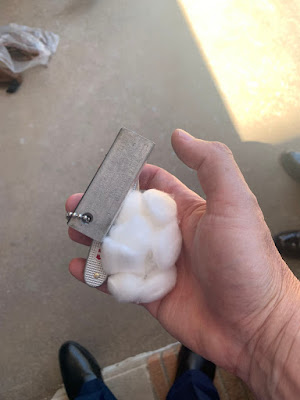Survival started in the classroom where we discussed what if? What would you do? We all had about the same ideas. Evacuate, First Aid, Shelter, Signal, Water, Food. The order can be tweaked based on the circumstances but its all pretty basic. They emphasized the STOP method! That means Stop, Think, Organize, Plan. It is a reminder that running around is not necessarily useful, be deliberate.
We covered a broad range of topics in the classroom and took breaks for practical lessons. One was the airline evacuation scenario. We did 3 evacuations, one through the front door, one through an over wing exit and the final was again through the door with a smoke filled cabin. When your visibility is only 1-2 feet it changes the process.
Our next adventure was in a big freezer where we tried various shelters. They keep the freezer at a comfortable 10 degrees F. We sat in a repurposed life raft and found it was a much better insulator than our crashed airframe. Yes they had a real airplane cabin we got to huddle in to really get a feel for the cold. We also tried those space blankets and they were surprisingly effective.
In the afternoon we went outside to start some fires. This is likely the only time I will start a fire on a government facility without being arrested. We tried various fire starters and learned the practical side of making things burn. Starting a fire in the wilderness is harder than it looks. I have practiced this skill as part of other classes and it is an art. The key is to have at least something to cheat a bit. I have a fire starter and dry kindling in my flight bag. Do you?
We then headed for the pool to spend 3 hours working on water survival. We got to work with rafts, learned how to work together in the water, how to manage injured survivors and even rode the basket. They have a rescue basket on a hoist hooked to the ceiling. We each got a turn to swim out and climb in to do a simulated lift to 15 feet or so. The instructor gives you a spin as you are lifted to simulate the ride on a real hoist. I asked for the double E ticket ride and it was a blast. After our swim we got to go home for the night and rest.
Day two started with spatial disorientation. The instruction was both classroom and practical. They placed one of our group in a Baranay chair (Basically a fancy office swivel chair) and demonstrated how easy it is to confuse a blindfolded person which direction they are spinning. We then took turns in a simulator where we flew instruments while they rotated the box. This allowed them to induce the confusion between what the instruments say and what your body tells you.
Having survived my Sim flight we moved on to Hypoxia. We learned the classroom stuff and then prepared to walk around at 27,000 feet. Not really, we would stay firmly on the ground. They have a chamber where they can change the percentage of Oxygen in the air. Normally this is 80% but if you drop it to 6% it's the same as being at 27,000 feet. At this altitude most people have about 5 minutes of consciousness.
Not all of it is useful though as you get stupider as your brain is starved of O2. We were given a clip board and a pulse oximeter and sent in. The instructors wore Oxygen masks so they could watch us and keep us safe. Stepping in I quickly had a slightly dizzy sensation followed by tingling at the extremities. This is the purpose of the simulation, you want to learn your symptoms. We were told to experience no more than 3 symptoms and then go on Oxygen but in no case to let our level drop below 60%. Typically when we fly we want our level to stay at 90% or better.
By 70% I had my symptoms recorded and donned my mask. A few breaths and I was back again and my pulse ox was up to 100%. Different people react differently but your symptoms stay the same over timer. The key is to know how you react so that at the first sign of hypoxia you can take action. We did it in two groups and while it was fun to do, watching the other people was also quite amusing. After this it was back to the airport and time to head home but that's another story.










No comments:
Post a Comment